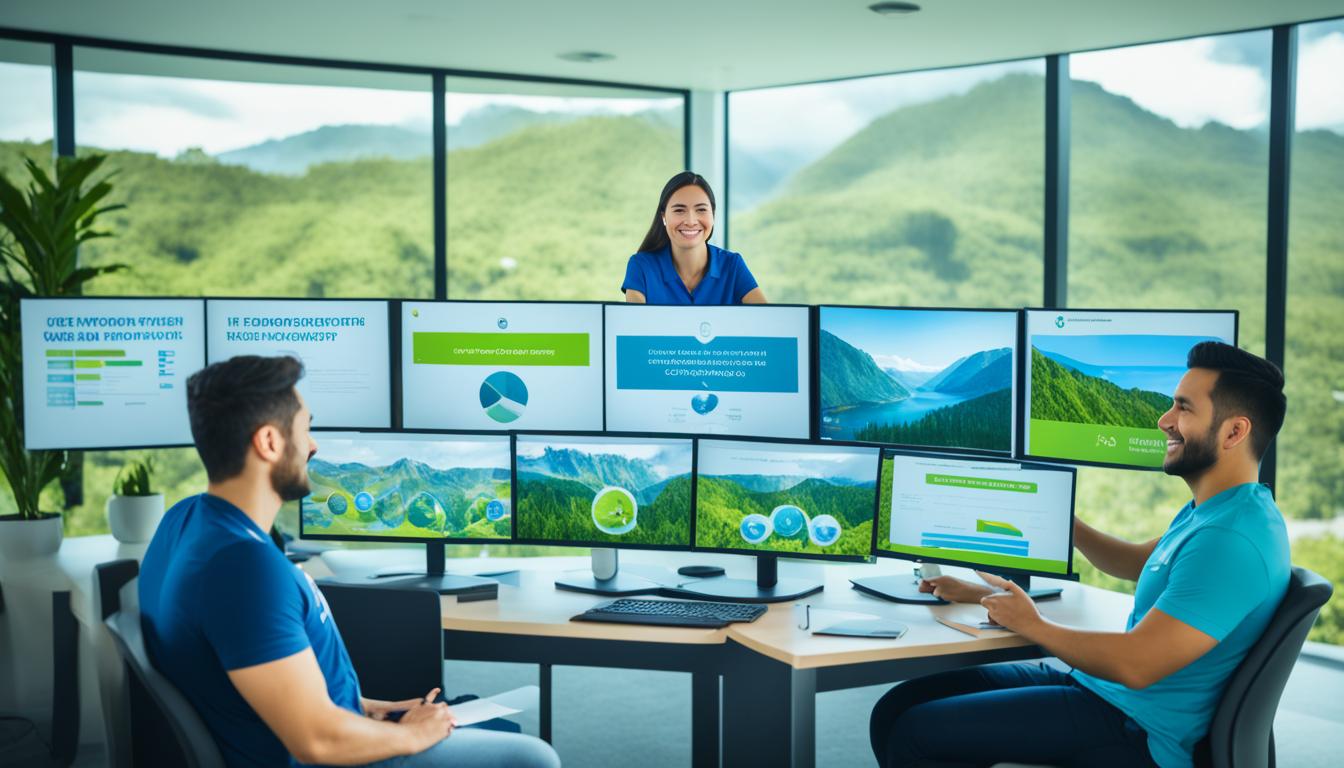Remote work has become the new norm in today’s modern workplace. With the rise of virtual teams and flexible work arrangements, organizations are exploring ways to foster engagement and productivity in remote employees. But what truly drives remote work engagement? And how can tracking systems impact the psychological well-being of remote workers?
In this article, we will delve into the psychology behind remote work engagement and tracking. We will uncover the key factors that influence engagement in virtual teams and explore strategies for maintaining productivity in remote work environments. Additionally, we will examine the effects of tracking on employee motivation and the delicate balance between surveillance and trust in remote work settings.
Join us on this journey as we explore the intricacies of remote work engagement and tracking, and discover how organizations can create a thriving virtual team that achieves optimal performance.
Key Takeaways:
- Remote work engagement is influenced by factors such as autonomy, flexibility, communication technologies, and company culture.
- The influence of tracking on employee motivation can be both positive and negative, requiring a careful balance.
- Remote work can have a significant psychological impact, affecting employee well-being, mental health, and job satisfaction.
- Effective tools and tactics exist for tracking productivity in remote teams, providing insights into work habits and opportunities for improvement.
- Strategies for sustaining telecommuting productivity include goal-setting, regular check-ins, and agile methodologies.
Understanding Remote Work and Employee Engagement
In today’s digital age, remote work has become increasingly prevalent, transforming the way organizations operate and employees work. As companies adapt to the changing landscape, it is crucial to understand the impact of remote work on employee engagement and explore effective strategies to foster collaboration and productivity in a digital workplace.
The Transition to Remote Work Environments
The transition from traditional office settings to remote work environments brings forth a unique set of challenges and opportunities. Organizations must navigate the shift in work dynamics and establish structures that support remote teams. Managing communication, ensuring access to necessary resources, and fostering a sense of connection and community are key aspects of this transition.
Measuring Engagement in a Digital Workplace
In a digital workplace, measuring employee engagement becomes crucial to understand the level of commitment, satisfaction, and motivation among remote employees. Tracking engagement provides valuable insights into factors influencing productivity and aids in the identification of areas for improvement. By utilizing appropriate metrics and survey tools, organizations can effectively monitor and enhance engagement levels in remote teams.
By comprehending the challenges associated with the transition to remote work environments and implementing effective measurement methods for engagement, organizations can empower their workforce to excel in the digital workplace. The next section will delve into the key factors influencing remote work engagement, including autonomy, communication technologies, and company culture.
Key Factors Influencing Remote Work Engagement
In order to maximize remote work engagement, organizations need to consider several key factors that contribute to employee satisfaction and productivity. This section will explore the role of autonomy and flexibility, the impact of communication and collaboration technologies, and strategies for maintaining a strong company culture online.
The Role of Autonomy and Flexibility
Autonomy and flexibility are crucial components of remote work engagement. When employees have the freedom to structure their work and have control over their schedules, they are more likely to feel motivated and engaged. Autonomy allows individuals to take ownership of their tasks and make decisions independently, while flexibility enables them to balance personal and professional responsibilities effectively.
Providing autonomy and flexibility in remote work environments can lead to increased job satisfaction, enhanced productivity, and a greater sense of work-life balance. It allows employees to work at their own pace, find a workflow that suits their preferences, and adapt to their unique circumstances. This sense of empowerment fosters a positive psychological state and encourages self-motivation.
Organizations can promote autonomy and flexibility by setting clear performance goals and providing guidelines rather than rigid rules. This empowers employees to take ownership of their work and find innovative solutions to challenges. Additionally, leveraging technology tools such as project management software and time tracking applications can help monitor progress while allowing employees the flexibility to structure their work according to their preferences.
Communication and Collaboration Technologies
Effective communication and collaboration technologies play a pivotal role in promoting remote work engagement. With the absence of face-to-face interactions, virtual teams heavily rely on communication tools to connect, collaborate, and build relationships.
Technologies such as video conferencing software, instant messaging platforms, and project management tools provide remote employees with the means to communicate in real-time, facilitate collaboration, and share information seamlessly. These tools bridge the gap between team members and enhance their ability to work together, irrespective of geographical distance.
By leveraging communication and collaboration technologies, organizations can foster a sense of belonging and promote effective teamwork among remote employees. Regular team meetings, virtual coffee breaks, and informal channels help establish meaningful connections and strengthen relationships, mirroring the social interactions encountered in physical office spaces. Creating opportunities for virtual collaboration and brainstorming sessions also encourages engagement and innovation.
Maintaining a Strong Company Culture Online
A strong company culture is instrumental in remote work engagement. It provides a sense of identity, purpose, and belonging, contributing to employee satisfaction and retention.
Organizations should focus on maintaining and nurturing their company culture in a remote work setting. Regularly communicating the company’s values, mission, and goals is essential for creating a shared sense of purpose among remote employees. This can be achieved through virtual town hall meetings, newsletters, or company-wide announcements.
Creating opportunities for virtual team-building activities, such as online workshops or social gatherings, can foster a sense of camaraderie and strengthen connections between team members. Encouraging cross-team collaboration and recognizing individual achievements through digital platforms also contribute to a positive company culture.
Organizations need to ensure that their remote work policies align with the existing company culture and values. Providing resources and support for remote employees’ well-being, professional development, and career growth further reinforces the company’s commitment to its workforce.
The Influence of Tracking on Remote Employee Motivation
In remote work environments, tracking employee performance and productivity has become increasingly important for organizations. Employee monitoring enables businesses to better understand the work patterns and behaviors of their remote employees. However, tracking can also have a significant impact on employee motivation and trust. In this section, we will explore the pros and cons of employee monitoring and its influence on remote employee motivation. We will also discuss how time tracking and productivity software like Time Champ can be integrated into motivational strategies to enhance performance and engagement.
Pros and Cons of Employee Monitoring
Employee monitoring can provide valuable insights into remote work habits and productivity levels. It allows managers to identify areas for improvement and make data-driven decisions. Here are some pros and cons of employee monitoring:
- Pros:
- Increases accountability and drives productivity
- Enables fair evaluation and recognition of employee efforts
- Identifies inefficiencies and bottlenecks in work processes
- Enhances data-driven decision making
- Cons:
- Can lead to micromanagement and reduced autonomy
- May create a culture of surveillance and mistrust
- Raises privacy and ethical concerns
- Can negatively impact employee morale and job satisfaction
It is important for organizations to find the right balance between monitoring and fostering trust in remote teams. Open communication and transparency around monitoring practices can help alleviate concerns and build a supportive work environment.
How Time Champ Integrates into Motivational Strategies
One way to integrate time tracking and productivity software into motivational strategies is by using tools like Time Champ. Time Champ is a comprehensive time tracking tool that allows remote employees to monitor their time usage, track their progress, and set productivity goals. It provides insights into work patterns, identifies areas for improvement, and helps individuals stay focused and disciplined.
With Time Champ, remote employees can:
- Track and visualize their time spent on different tasks or projects
- Set productivity goals and receive notifications to stay on track
- Analyze their productivity trends and identify areas for improvement
- Review their performance and share progress with their managers
The use of tools like Time Champ can not only enhance remote employee motivation but also provide managers with valuable data to optimize team performance and identify training or development opportunities.
In the next section, we will delve into the psychological impact of remote work engagement and discuss ways to promote psychological well-being in a remote work environment.
Remote Work Engagement: The Psychological Impact
In today’s remote work landscape, it is crucial to understand the psychological impact of remote work engagement on employees. Working remotely can have both positive and negative effects on employee well-being, mental health, and job satisfaction. By recognizing and addressing these effects, organizations can create a supportive and conducive remote work environment.
Remote work offers various benefits that can positively impact employee well-being. The flexibility and autonomy it provides can enhance work-life balance and reduce stress levels. Employees have the freedom to design their work environment, which can lead to increased comfort and productivity. Moreover, remote work can eliminate the daily commute, allowing individuals to allocate more time and energy to their personal lives.
However, remote work also presents unique challenges and stressors. The lack of face-to-face interaction and social isolation can contribute to feelings of loneliness and isolation. Remote workers may miss the camaraderie and spontaneous interactions that occur in traditional office settings. Additionally, the blurring of boundaries between work and personal life can lead to longer hours and burnout.
Organizations should prioritize promoting psychological well-being in a remote work environment. Here are some strategies to consider:
- Encourage regular breaks and time off to prevent burnout and promote work-life balance.
- Facilitate virtual socialization through online team-building activities and virtual coffee breaks.
- Provide support and resources for maintaining mental health, such as employee assistance programs or counseling services.
- Promote open communication and regular check-ins to ensure employees feel connected and supported.
- Offer training and workshops on stress management and resilience-building techniques.
By acknowledging the psychological impact of remote work engagement and implementing strategies to support employee well-being, organizations can create a positive and thriving remote work culture.
Tracking Productivity: Tools and Tactics for Remote Teams
In order to effectively monitor and enhance productivity in remote teams, it is essential to implement the right tools and tactics. By optimizing the use of productivity software, teams can streamline their workflows, track progress, and ensure efficient remote work performance. Additionally, leveraging analytics and reporting can provide valuable insights into remote work habits, enabling teams to identify areas for improvement and drive productivity to new heights.
Optimizing Use of Productivity Software
Productivity software offers a wide range of features and capabilities that can greatly benefit remote teams. By implementing the following best practices, teams can optimize their use of productivity software and maximize its impact:
- Set clear goals and expectations: Clearly define the objectives and deliverables for each remote team member. By providing a clear roadmap, productivity software can assist in tracking progress and ensuring alignment with organizational goals.
- Streamline communication and collaboration: Leverage the collaborative features of productivity software to facilitate seamless communication and collaboration among remote team members. This can include real-time messaging, video conferencing, and task management functionalities.
- Establish accountability: Use productivity software to assign tasks, set deadlines, and track progress. This promotes accountability and ensures that remote team members are aware of their responsibilities and can take ownership of their work.
- Encourage transparency and documentation: Use productivity software to maintain transparency by documenting work processes, actions taken, and decisions made. This helps remote teams stay informed about ongoing projects and fosters a culture of transparency and knowledge sharing.
Analytics and Reporting: Insights into Remote Work Habits
By leveraging analytics and reporting capabilities, remote teams can gain valuable insights into work habits and performance patterns. This data-driven approach can assist teams in identifying strengths, weaknesses, and areas for improvement. Some key benefits of analytics and reporting for remote teams include:
- Performance evaluation: Analyzing productivity data allows teams to assess individual and team performance objectively. By understanding productivity patterns, teams can identify bottlenecks, redistribute workload, and allocate resources more effectively.
- Identifying productivity trends: Analytics and reporting provide visibility into productivity trends over time. This information can help teams identify peak productivity periods, track the impact of changes in work processes, and optimize work schedules.
- Understanding work habits: By analyzing patterns in work habits, teams can identify factors that contribute to productivity or hinder performance. This insight allows teams to make data-driven decisions to improve workflows, optimize task allocation, and enhance remote work experiences.
- Improving future planning: Historical data provided by analytics and reporting can assist teams in forecasting future workloads, resource requirements, and project timelines. This proactive approach enables teams to better plan and allocate resources to ensure optimal productivity.
Strategies for Sustaining Telecommuting Productivity Tips
In order to maintain high levels of productivity while telecommuting, it is essential to implement effective strategies. This section will focus on two key strategies that can help remote workers stay on track and ensure optimal performance:
Goal-Setting and Performance Metrics
Setting clear and measurable goals is crucial for telecommuting productivity. By defining specific objectives, remote workers can maintain focus and motivation. It is recommended to establish both short-term and long-term goals to maintain a sense of progress and accomplishment. Performance metrics are another important tool for tracking productivity. By quantifying progress and measuring results, remote workers can assess their performance and make necessary adjustments to stay on target.
Regular Check-ins and Agile Methodologies
Regular check-ins with team members and managers are essential for maintaining accountability and collaboration in a remote work setting. By scheduling frequent virtual meetings, remote workers can stay updated on project status, share progress, and seek guidance when needed. Agile methodologies, such as Scrum or Kanban, can also be highly effective in managing remote teams. These methodologies promote transparency, adaptability, and regular communication, enabling teams to work together efficiently and effectively.
| Strategy | Benefits |
|---|---|
| Goal-Setting and Performance Metrics |
|
| Regular Check-ins and Agile Methodologies |
|
Virtual Team Collaboration: Best Practices
In remote work environments, effective collaboration is essential for the success of virtual teams. Implementing best practices for virtual team collaboration can enhance communication, foster engagement, and maximize productivity. In this section, we will explore some key strategies and techniques to facilitate collaboration in remote teams.
1. Foster Open Communication:
Open and transparent communication is the foundation of successful virtual team collaboration. Encourage team members to actively participate in discussions, share ideas, and provide feedback. Utilize communication tools such as video conferencing, instant messaging, and project management software to facilitate real-time communication and ensure everyone is on the same page.
2. Use Collaboration Tools:
Collaboration tools can streamline communication, enhance workflow, and facilitate seamless collaboration in remote teams. Project management platforms like Asana, Trello, or Basecamp can help to assign tasks, track progress, and manage project timelines. File-sharing platforms such as Google Drive or Dropbox enable easy access to shared documents, ensuring team members have the latest information at their fingertips.
“Coming together is a beginning; keeping together is progress; working together is success.” – Henry Ford
3. Establish Clear Goals and Roles:
Clearly defining goals, objectives, and individual roles within the team is crucial for effective collaboration. This clarity helps team members understand their responsibilities, ensures alignment, and promotes accountability. Setting milestones and regularly reviewing progress can keep everyone motivated and focused on shared objectives.
4. Schedule Regular Team Meetings:
Regular team meetings provide an opportunity for virtual team members to connect, discuss progress, share updates, and address any challenges. These meetings can be held via video conferencing platforms like Zoom or Microsoft Teams. By scheduling regular meetings, you can foster a sense of belonging, encourage collaboration, and maintain team cohesion.
5. Encourage Virtual Team-Building Activities:
Building relationships and fostering a sense of community in remote teams is vital for collaboration. Encourage virtual team-building activities to promote social interaction and strengthen connections among team members. These activities can include virtual coffee breaks, team-building games, or virtual happy hours.
6. Promote Diversity and Inclusion:
In virtual teams, diversity and inclusion play a significant role in fostering collaboration. Embrace diverse perspectives, encourage open-mindedness, and create a safe space for all team members to contribute. By valuing and respecting different opinions and experiences, you can create a collaborative environment that brings out the best in each team member.
Collaboration Tools Comparison
| Tool | Features | Price |
|---|---|---|
| Asana | Task management, project tracking, collaboration dashboards | Free for basic features, paid plans starting at $10.99 per user/month |
| Trello | Visual project management, Kanban-style boards, task cards | Free for basic features, paid plans starting at $10 per user/month |
| Basecamp | Task lists, document sharing, team messaging | Flat fee of $99 per month for unlimited users |
| Google Drive | File storage, document collaboration, real-time editing | Free for personal use, paid plans starting at $6 per user/month for business |
| Dropbox | File syncing, document sharing, cloud storage | Free for basic features, paid plans starting at $12.50 per user/month for business |
By implementing these best practices for virtual team collaboration, remote teams can overcome challenges, enhance productivity, and achieve their shared goals. Building a collaborative culture and leveraging the right tools and techniques will empower virtual teams to thrive and succeed in remote work environments.
Ensuring Equilibrium Between Surveillance and Trust
In the world of remote work, striking a balance between surveillance and trust is crucial for maintaining a healthy work environment. While employee monitoring and tracking software offer valuable insights into productivity and performance, it is essential to address privacy concerns and ethical considerations.
Privacy Concerns and Ethical Considerations
When implementing surveillance measures, organizations must prioritize the privacy of their employees. The use of tracking software may raise concerns about the collection and storage of personal data. It is imperative to ensure compliance with data protection regulations and establish clear policies regarding data usage and access.
Moreover, ethical considerations come into play when introducing surveillance measures. It is vital to strike a balance between monitoring productivity and respecting individual autonomy. Organizations must consider the potential impact on employee well-being, trust, and job satisfaction.
Cultivating Trust While Using Tracking Software
To foster trust in remote work environments, transparency is key. Clear communication about the purpose and scope of monitoring initiatives helps build trust between employers and employees. By involving employees in the decision-making process and addressing their concerns, organizations can create a culture of trust and collaboration.
Managers and supervisors should prioritize open conversations and maintain regular check-ins with their remote teams. Establishing clear expectations and goals, along with regular feedback, can help employees feel supported and motivated. This approach creates an atmosphere of trust and ensures that tracking software is perceived as a tool for improvement rather than a surveillance mechanism.
Additionally, organizations can promote trust by focusing on results rather than micromanaging employees’ every move. Emphasizing task completion and outcomes allows employees to work autonomously while still being accountable for their responsibilities.
| Surveillance | Trust | |
|---|---|---|
| Definition | The act of monitoring and tracking employee activities | The belief in the reliability, integrity, and honesty of employees |
| Objective | To ensure productivity, identify areas of improvement, and manage risk | To foster a positive work environment, promote autonomy, and encourage collaboration |
| Concerns | Privacy, invasion of personal space, potential misuse of data | Mistrust, micromanagement, decreased employee morale |
| Strategies | Transparent communication, clear policies, compliance with regulations | Open dialogue, involvement in decision-making, result-oriented approach |
By implementing these strategies, organizations can ensure that the use of tracking software maintains a balance between surveillance and trust. Employees can feel confident that their privacy is respected while still benefiting from the insights and performance improvements that monitoring provides.
Personalizing The Remote Work Experience for Filipino Workers
In order to ensure a successful remote work experience for Filipino workers, it is important to understand and address their unique needs and circumstances. By analyzing case studies from the Philippines and adapting global practices to suit the local context, organizations can create an environment that promotes productivity, engagement, and overall well-being.
Adapting Global Practices to Local Contexts
While global practices and strategies for remote work may serve as a valuable starting point, it is crucial to adapt these practices to suit the specific needs and cultural nuances of the Filipino workforce. By taking into account factors such as communication styles, work-life balance expectations, and local work norms, organizations can create a remote work experience that resonates with Filipino workers and enhances their engagement and performance.
| Global Practice | Adaptation for Filipino Workers |
|---|---|
| Regular team check-ins | Account for Filipino workers’ preference for frequent and open communication channels, such as video calls or instant messaging apps. |
| Flexible work hours | Consider Filipino workers’ family-oriented culture and allow flexibility in setting work hours to accommodate personal responsibilities. |
| Recognition and rewards | Recognize and reward achievements and contributions in culturally relevant ways, such as public acknowledgments or team celebrations. |
Conclusion: Balancing Engagement and Tracking for Optimal Performance
In this article, we have explored the psychology behind remote work engagement and tracking, and the importance of balancing these two elements for optimal performance in virtual teams. We have discovered that remote work engagement relies on factors such as autonomy, flexibility, effective communication technologies, and a strong company culture. These elements foster motivation, productivity, and job satisfaction among remote employees.
However, it is essential to strike a balance between engagement and tracking in remote work environments. While tracking productivity can provide insights into work habits and help identify areas for improvement, it must be implemented with caution to avoid negatively impacting employee motivation and trust. Companies must consider the pros and cons of employee monitoring and opt for ethical practices that prioritize transparency and open communication.
To foster a dedicated and productive virtual team while ensuring employee satisfaction and well-being, organizations can adopt several recommendations. These include setting clear goals and performance metrics, regularly checking in with employees, and leveraging agile methodologies for effective collaboration. Additionally, implementing communication strategies, collaboration tools, and project management techniques can enhance virtual team collaboration, trust, and engagement.
By prioritizing both engagement and tracking, companies can create a positive remote work experience that promotes optimal performance and growth. As the world embraces remote work, it is crucial to adapt global practices to the unique needs and cultural nuances of the Filipino workforce. By doing so, organizations can pave the way for a successful and fulfilling remote work environment in the Philippines.
FAQ
What factors influence remote work engagement?
Autonomy, flexibility, effective communication, and collaboration technologies, and maintaining a strong company culture online all contribute to remote work engagement.
How does tracking impact remote employee motivation?
Employee monitoring has its pros and cons. While it can enhance motivation and trust, it also raises concerns about privacy and ethical considerations.
What are the psychological effects of remote work?
Remote work can affect employee well-being, mental health, and job satisfaction. It is important to address potential challenges and stressors to promote psychological well-being.
What tools and tactics can be used to track productivity in remote teams?
Productivity software and analytics can effectively monitor and enhance remote work performance by providing insights into work habits and identifying areas for improvement.
How can telecommuting productivity be sustained?
Setting goals, using performance metrics, regular check-ins, and adopting agile methodologies can help maintain productivity and accountability in remote teams.
What are the best practices for virtual team collaboration?
Effective communication strategies, collaboration tools, and project management techniques encourage collaboration and engagement in virtual teams. Building trust and strengthening relationships are also crucial.
How can organizations balance surveillance and trust in remote work environments?
While employee monitoring raises privacy concerns, transparency, open communication, and cultivating trust can help strike a balance between surveillance and trust.
How can the remote work experience be personalized for Filipino workers?
By analyzing case studies from the Philippines and adapting global practices to suit the specific needs and cultural nuances of the Filipino workforce.
What is the importance of balancing engagement and tracking for optimal performance in remote work environments?
Achieving a balance between engagement and tracking is crucial for maintaining workforce productivity, satisfaction, and overall success in remote work settings.





